
Discusses how the structures of the noseinteract to produce our sense of smell.Has links to lab activities and teacher lessonson this topic.
- Subject:
- Science
- Material Type:
- Reading
- Provider:
- University of Washington
- Date Added:
- 08/28/2023

Discusses how the structures of the noseinteract to produce our sense of smell.Has links to lab activities and teacher lessonson this topic.
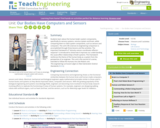
Students learn about the human body's system components, specifically its sensory systems, nervous system and brain, while comparing them to robot system components, such as sensors and computers. The unit's life sciences-to-engineering comparison is accomplished through three lessons and five activities. The important framework of "stimulus-sensor-coordinator-effector-response" is introduced to show how it improves our understanding the cause-effect relationships of both systems. This framework reinforces the theme of the human body as a system from the perspective of an engineer. This unit is the second of a series, intended to follow the Humans Are Like Robots unit.

This video segment explores the role of touch in the development of young animals, including humans. Footage from NOVA: "Mystery of the Senses: Touch." [2:57]
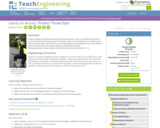
Students design and build prototypes for protective eyewear. They choose different activities or sports that require protective eyewear and design a device for that particular use. Students learn about the many ways in which the eyes can be damaged and how engineers incorporate different features and materials into eyewear designs to best protect the eyes.

Psychology is designed to meet scope and sequence requirements for the single-semester introduction to psychology course. The book offers a comprehensive treatment of core concepts, grounded in both classic studies and current and emerging research. The text also includes coverage of the DSM-5 in examinations of psychological disorders. Psychology incorporates discussions that reflect the diversity within the discipline, as well as the diversity of cultures and communities across the globe.Senior Contributing AuthorsRose M. Spielman, Formerly of Quinnipiac UniversityContributing AuthorsKathryn Dumper, Bainbridge State CollegeWilliam Jenkins, Mercer UniversityArlene Lacombe, Saint Joseph's UniversityMarilyn Lovett, Livingstone CollegeMarion Perlmutter, University of Michigan

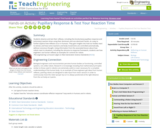
Students observe and test their reflexes, including the (involuntary) pupillary response and (voluntary) reaction times using their dominant and non-dominant hands, as a way to further explore how reflexes occur in humans. They gain insights into how our bodies react to stimuli, and how some reactions and body movements are controlled automatically, without conscious thought. Using information from the associated lesson about how robots react to situations, including the stimulus-to-response framework, students see how engineers use human reflexes as examples for controls for robots.
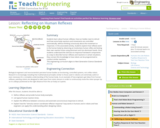
Students learn about human reflexes, how our bodies react to stimuli and how some body reactions and movements are controlled automatically, without thinking consciously about the movement or responses. In the associated activity, students explore how reflexes work in the human body by observing an involuntary human reflex and testing their own reaction times using dominant and non-dominant hands. Once students understand the stimulus-to-response framework components as a way to describe human reflexes and reactions in certain situations, they connect this knowledge to how robots can be programmed to conduct similar reactions.

This resource provides detailed facts about alligators and crocodils, including how to distinguish between a crocodile and an alligator, information on their eating habits, how a mama crocodile protects her young, and more. There are numerous pictures and a sound clip is provided.

This resource provides detailed information about the boa, as well as several pictures and an audio clip.

This resource provides detailed information about the flamingo as well as several pictures. [2 min, 9 sec]

This resource provides detailed information about the python, as well as several pictures and an audio clip.
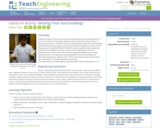
Students consider human senses and the many everyday human-made sensors so common in their lives. They learn about the three components of biosensorsâa special type of sensorâand their functions and importance. With this understanding, students identify various organs in the human body that behave as sensors, such as the pancreas. Using LEGO® MINDSTORMS® NXT robots, provided rbt robot programs and LEGO sensors (light, ultrasonic, sound, touch), students gain first-hand experience with sensors and come to see how engineer-designed sensors play important roles in our daily lives, informing people of their surroundings and ultimately improving our quality of life.

This lesson will describe how receptors allow you to detect smells and tastes and will describe the link between taste and smell. It is 1 of 2 in the series titled "Smell & Taste." [6:51]
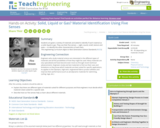
Students are given a variety of materials and asked to identify each material as a solid, liquid or gas. They use their five senses ŰÓ sight, sound, smell, texture and taste ŰÓ to identify the other characteristics of each item.

Explore our ability to sense the environment through our body. [7:43]
Khan Academy learning modules include a Community space where users can ask questions and seek help from community members. Educators should consult with their Technology administrators to determine the use of Khan Academy learning modules in their classroom. Please review materials from external sites before sharing with students.
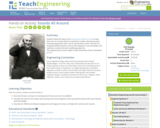
Students follow the steps of the engineering design process to create their own ear trumpet devices (used before modern-day hearing aids), including testing them with a set of reproducible sounds. They learn to recognize different pitches, and see how engineers must test designs and materials to achieve the best amplifying properties.

Read about the wonderful changes that take place when spring arrives. Book includes audio narration in 17 additional languages with text in English.

Charles Darwin called the brain of the ant "one of the most marvelous atoms of matter in the world." Anna Stockl takes us inside the tiny but mighty insect brain. [4:22]